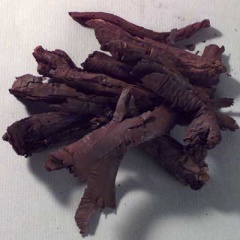Alkanet (root)
| Infobox on Alkanet (root) | |
|---|---|
| Example of Alkanet (root) |  |
| Facts | |
| Origin | Europe/Asia |
| Stowage factor (in m3/t) | |
| Humidity / moisture | |
| Ventilation | |
| Risk factors | See text |
Alkanet (root)
Description
Alkanet is a biennial or perennial herb that grows to 12 inches high. It is similar to borage, with rough leaves, thick tap root and small bright blue flowers in early summer. The name Anchusa is derived from the Greek anchousa for paint, from the use of the root as a dye. The species are hispid or pubescent herbs, with oblong, entire leaves, and bracteated racemes, rolled up before the flowers expand. The corolla is rather small, between funnel and salver-shaped; usually purplish-blue, but in some species yellow or whitish; the calyx enlarges in fruit. The root, which is often very large in proportion to the size of the plant, yields in many of the species a red dye from the rind.
Alkanet, as found in commerce, is in pieces 7 to 10 cm. long, and from 5 to 15 mm. thick, somewhat twisted, consisting of a dark-red, easily separable bark, and an internal ligneous portion, which is reddish externally, whitish near the center, and composed of numerous distinct, slender, cohering fibers. As it comes to us it is usually much decayed internally, very light, and of a loose, almost spongy texture. The fresh root has a faint odor, and a bitter, astringent taste; but when dried it is nearly inodorous and insipid. Its coloring principle, which abounds mostly in the cortical part, is soluble in alcohol, ether, and the oils, to which it imparts a deep red color, but is insoluble in water. It may be obtained by first exhausting the root with water, and then treating it with a weak solution of potassium or sodium carbonate, from which the coloring principle may be precipitated by an acid. It possesses acid properties, forming with the alkalis and neutral compounds, which are of a blue color, and soluble in alcohol and ether. Its weak acid character resembles that of alizarin, to which it is chemically related, as when distilled with zinc dust it yields methyl-anthracene. It has also received the names of anchusin and alkannin.
Pigments and dyes are not identical, although there are cases in which the same coloring matter which yields a dye or stain may give rise to a pigment. A pigment is, in fact, a substance which is insoluble in the vehicle with which it is mixed to make a paint, while a dye is soluble. A lake pigment is a natural organic pigment prepared when a dye has been precipitated on a powdered, colorless, inorganic substrate. Because of its transparency, aluminum hydroxide is the most commonly used substrate or carrier. Barites, such as barium sulfate, provide an opaque lake pigment. Other compounds used as carriers are: chalk, clay, gypsum, tin oxide, zinc oxide, white earth, and green earth. Often a mordant, such as tannic acid, lactic acid, or sodium phosphate, is used to fix the dye to the substrate.
Lake pigments made from alkanet root are considered to be fugitive.
No data has been published on the oil absorption and grinding qualities of lake pigments made from alkanet root.
Application
In dyeing, alkanet root gives burgundies and purples in an alkaline dye bath. Extracting first with alcohol enhances the color and then adding the extract solution to pre-mordanted wool or silk in a dye bath. Precipitated on an inert base, alkanet root yields a purple lake pigment. Also used in varnishes for fine wood products, such as violins.
Shipment / Storage
The product is either packed in cases or bags. It should be stowed cool.
Risk factors
- Moisture damage
- May be damaged by excessive heating.











